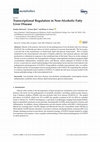Papers by Sandra Steensels
<p>(<b>A</b>) On-relaxations and (<b>B</b>) off-contractions of COE... more <p>(<b>A</b>) On-relaxations and (<b>B</b>) off-contractions of COEC-fed WT or Bmal1-KO mice under ALFF and RF conditions with gradually restricted food availability. (ALFF: N = 8–14 mice/genotype, n = 16–17 strips; RF: N = 4–8 mice/genotype, n = 6–12 strips). *<i>P</i><0.05, **<i>P</i><0.01, ***<i>P</i><0.001 WT vs. ALFF; # <i>P</i><0.05, ## <i>P</i><0.001 Bmal1-KO vs. ALFF.</p
<p>Relative hypothalamic AgRP (a), NPY (b) and POMC (c) mRNA expression levels in HFD-obese... more <p>Relative hypothalamic AgRP (a), NPY (b) and POMC (c) mRNA expression levels in HFD-obese WT (n = 7–10) and α-gust<sup>-/-</sup> (n = 6–9) mice after 4 weeks of daily gavage with water, DB or quinine. *: P<0.05 water vs DB or Q; #: P<0.05; ##<0.01 treatment (water vs DB) x genotype.</p
<p>(a) The sum of gonadal, subcutaneous and mesenteric white adipose tissue mass as percent... more <p>(a) The sum of gonadal, subcutaneous and mesenteric white adipose tissue mass as percentage of total body weight in WT (n = 16) and α-gust<sup>-/-</sup> mice (n = 16). (b) Plasma leptin levels in WT (n = 10) and α-gust<sup>-/-</sup> mice (n = 11). (c-e) Relative gonadal, subcutaneous and mesenteric fat UCP1 mRNA levels in WT (n = 6–9) and α-gust<sup>-/-</sup> mice (n = 6–9). (f) Relative intrascapular brown adipose tissue UCP1 protein level expression in WT (n = 4) and α-gust<sup>-/-</sup> mice (n = 4) as determined by Western blot. *: P<0.05, **: P<0.01, ***: P<0.001 WT vs α-gust<sup>-/-</sup>.</p

<p>Representative H&E stained fundic sections of COEC-fed WT or Bmal1-KO mice under ALF... more <p>Representative H&E stained fundic sections of COEC-fed WT or Bmal1-KO mice under ALFF (<b>A,E</b>) or RF (<b>B,F</b>) conditions with gradually restricted food availability. (<b>C,G</b>) Higher magnifications of RF sections with arrows pointing towards PMNs. Representative peroxidase-stained fundic sections of WT (<b>D</b>) and Bmal1-KO (<b>H</b>) mice under RF conditions. Average number of PMNs per mm<sup>2</sup> (<b>I</b>) and peroxidase positive cells per mm<sup>2</sup> (<b>J</b>) in the fundus of WT (n = 4–5/group) or Bmal1-KO mice (n = 4/group) under ALFF or RF conditions. (<b>K</b>) MPO activity levels of WT (n = 9–20/group) or Bmal1-KO mice (n = 6–7/group) under ALFF or RF conditions. *<i>P</i><0.01, **<i>P</i><0.001 ALFF vs. RF; # <i>P</i><0.05 WT vs. Bmal1-KO. (LM = longitudinal muscle layer, CM = circular muscle layer, SM = submucosa, M = mucosa).</p
<p>(<b>A–B</b>) Changes in body weight of (<b>A</b>) COEC-fed WT (n... more <p>(<b>A–B</b>) Changes in body weight of (<b>A</b>) COEC-fed WT (n = 11–21/group) or (<b>B</b>) Bmal1-KO mice (n = 7–11/group) under ALFF or RF conditions with gradually restricted food availability. (<b>C</b>) Total fat pad mass of COEC-fed WT (n = 7–12/group) and Bmal1-KO (n = 6/group) mice under ALFF or RF conditions with gradually restricted food availability. (<b>D–F</b>) Gastric mRNA expression of the proinflammatory cytokines IL-1β (<b>D</b>), IL-6 (<b>E</b>) and IL-1α (<b>F</b>) of COEC-fed WT (n = 9–19 mice/group) or Bmal1-KO mice (n = 6–7 mice/group) under ALFF or RF conditions with gradually restricted food availability. *<i>P</i><0.001 ALFF vs. RF; # <i>P</i><0.01 WT vs. Bmal1-KO.</p

<p>(a-b) Changes in body weight during daily intra-gastric administration of water, DB (60 ... more <p>(a-b) Changes in body weight during daily intra-gastric administration of water, DB (60 μmol/kg) or Q (160 μmol/kg) for 4 weeks in high-fat diet (15 weeks) obese (a) WT (n = 9–12) and (b) α-gust<sup>-/-</sup> mice (n = 8–12). Results are expressed as percentage change from baseline, defined as the mean body weight measured during one week before the treatment. (c) Combined weight of gonadal, subcutaneous and mesenteric fat pads as percentage of total body weight of control or bitter treated WT (n = 9–12) and α-gust<sup>-/-</sup> mice (n = 9–12), at sacrifice. (d) Relative mRNA expression of UCP1 in gonadal WAT of control or bitter treated WT (n = 7–9) and α-gust<sup>-/-</sup> (n = 7–8) mice. (e-f) Changes in energy intake during the 4-week treatment period in (e) WT (n = 6–8) and (f) α-gust<sup>-/-</sup> mice (n = 7–8), expressed as percentage change from baseline, defined as the mean energy intake measured during 9 days before the treatment. **: P<0.01; ***: P<0.001 water vs bitter; ##: P<0.01 treatment (water vs DB) x genotype.</p
<p>(a) Representative Oil-Red O stained 3T3-F442A cells at day 12 of differentiation in the... more <p>(a) Representative Oil-Red O stained 3T3-F442A cells at day 12 of differentiation in the presence of vehicle, 150 μM DB or 100 μM Q. (b) Quantification of the Oil-Red O uptake at differentiation day 6 (n = 4) and 12 (n = 8). (c-d) Relative mRNA expression of the markers leptin and adiponectin during differentiation in the absence and presence of DB or Q (n = 6). (e) Trypan blue cell viability assay, presented as the amount of dead cells (% cells stained) after the 12-day differentiation period in the absence and presence of DB or Q (n = 3). **: P<0.01, ***: P<0.001 vehicle vs bitter.</p
<p>Gastric mRNA expression of the proinflammatory cytokines IL-1β (<b>A</b>, &l... more <p>Gastric mRNA expression of the proinflammatory cytokines IL-1β (<b>A</b>, <b>E</b>), IL-6 (<b>B</b>, <b>F</b>) and IL-1α (<b>C</b>, <b>G</b>) and MPO activity (<b>D</b>, <b>H</b>) of normal chow-fed WT (n = 7–16/group) or GHSR-KO (n = 6–9/group) mice (<b>A–D</b>) or COEC-fed WT mice (n = 5–6/group) (<b>E–H</b>) under different feeding conditions. *<i>P</i><0.05, **<i>P</i><0.01, ***<i>P</i><0.001 vs. ALFF. (AU = arbitrary units).</p
<p>(a) Time course of body weight of WT (n = 16) and α-gust<sup>-/-</sup> (n = ... more <p>(a) Time course of body weight of WT (n = 16) and α-gust<sup>-/-</sup> (n = 16) mice, on a high-fat diet for 19 weeks post-weaning. (b) Energy intake (kcal/day) of WT (n = 16) and α-gust<sup>-/-</sup> (n = 16) mice during the last 4 weeks before sacrifice. (c-d) Relative hypothalamic AgRP and POMC mRNA levels in WT (n = 10) and α-gust<sup>-/-</sup> (n = 9) mice after 19 weeks on a HFD. (e-f) Respiratory quotient and heat production, measured continuously during 1 week in WT (n = 8) and α-gust<sup>-/-</sup> (n = 8) mice. *: P<0.05; **: P<0.01, ***: P<0.001 WT vs α-gust<sup>-/-</sup>.</p
Neurogastroenterology and Motility, 2015
Neurogastroenterology and Motility, 2016
Journal of Molecular Neuroscience, 2014

Annual Review of Physiology, 2018
The gastrointestinal tract represents the largest interface between the human body and the extern... more The gastrointestinal tract represents the largest interface between the human body and the external environment. It must continuously monitor and discriminate between nutrients that need to be assimilated and harmful substances that need to be expelled. The different cells of the gut epithelium are therefore equipped with a subtle chemosensory system that communicates the sensory information to several effector systems involved in the regulation of appetite, immune responses, and gastrointestinal motility. Disturbances or adaptations in the communication of this sensory information may contribute to the development or maintenance of disease. This is a new emerging research field in which perception of taste can be considered as a novel key player participating in the regulation of gut function. Specific diets or agonists that target these chemosensory signaling pathways may be considered as new therapeutic targets to tune adequate physiological processes in the gut in health and dis...

Scientific Reports, 2015
Taste receptors on enteroendocrine cells sense nutrients and transmit signals that control gut ho... more Taste receptors on enteroendocrine cells sense nutrients and transmit signals that control gut hormone release. This study aimed to investigate the amino acid (AA) sensing mechanisms of the ghrelin cell in a gastric ghrelinoma cell line, tissue segments and mice. Peptone and specific classes of amino acids stimulate ghrelin secretion in the ghrelinoma cell line. Sensing of L-Phe occurs via the CaSR, monosodium glutamate via the TAS1R1-TAS1R3 while L-Ala and peptone act via 2 different amino acid taste receptors: CaSR & TAS1R1-TAS1R3 and CaSR & GPRC6A, respectively. The stimulatory effect of peptone on ghrelin release was mimicked ex vivo in gastric but not in jejunal tissue segments, where peptone inhibited ghrelin release. The latter effect could not be blocked by receptor antagonists for CCK, GLP-1 or somatostatin. In vivo, plasma ghrelin levels were reduced both upon intragastric (peptone or L-Phe) or intravenous (L-Phe) administration, indicating that AA- sensing is not polarize...
Neurogastroenterology and Motility, 2015

Scope: Enteroendocrine cells sense nutrients through taste receptors similar to those on the tong... more Scope: Enteroendocrine cells sense nutrients through taste receptors similar to those on the tongue. Sweet and fatty acid taste receptors (FFAR) coupled to the gustatory G‐protein, gustducin, on enteroendocrine cells play a role in gut hormone release. We studied if supplementation of artificial (sucralose) or prebiotic (oligofructose; OFS) sweeteners target gustducin‐mediated signaling pathways to alter gut hormone release and reduce obesity‐associated disorders. Methods and results: Wild‐type (WT) and α‐gustducin knockout (α‐gust−/−) mice were fed a high‐fat diet and gavaged once daily (8 wk) with water or equisweet concentrations of sweeteners. OFS but not sucralose decreased body weight gain (−19 ± 3%, p < 0.01), fat pad mass (−55 ± 6%, p < 0.001), and insulin resistance (−39 ± 5%, p < 0.001) independent of α‐gustducin. Neither sweetener improved glucose intolerance, while solely OFS improved the disturbed colonic permeability. OFS decreased (−65 ± 8%, p < 0.001) pla...

Advanced non-alcoholic fatty liver disease (NAFLD) is a rapidly emerging global health problem as... more Advanced non-alcoholic fatty liver disease (NAFLD) is a rapidly emerging global health problem associated with pre-disposing genetic polymorphisms, most strikingly an isoleucine to methionine substitution in patatin-like phospholipase domain-containing protein 3 (PNPLA3-I148M). Here, we study how human hepatocytes with PNPLA3 148I and 148M variants engrafted in the livers of chimeric mice respond to a hypercaloric Western-style diet. As early as 4 weeks, mice developed dyslipidemia, impaired glucose tolerance, and steatohepatitis selectively in the human graft, followed by pericellular fibrosis after 8 weeks of hypercaloric feeding. The PNPLA3 148M variant, either from a homozygous 148M human donor or overexpressed in a homozygous 148I donor background, caused widespread microvesicular steatosis and even more severe steatohepatitis. We conclude that PNPLA3 148M in human hepatocytes exacerbates NAFLD. These models will facilitate mechanistic studies into human genetic variants associ...

Metabolites
Obesity is the primary risk factor for the pathogenesis of non-alcoholic fatty liver disease (NAF... more Obesity is the primary risk factor for the pathogenesis of non-alcoholic fatty liver disease (NAFLD), the worldwide prevalence of which continues to increase dramatically. The liver plays a pivotal role in the maintenance of whole-body lipid and glucose homeostasis. This is mainly mediated by the transcriptional activation of hepatic pathways that promote glucose and lipid production or utilization in response to the nutritional state of the body. However, in the setting of chronic excessive nutrition, the dysregulation of hepatic transcriptional machinery promotes lipid accumulation, inflammation, metabolic stress, and fibrosis, which culminate in NAFLD. In this review, we provide our current understanding of the transcription factors that have been linked to the pathogenesis and progression of NAFLD. Using publicly available transcriptomic data, we outline the altered activity of transcription factors among humans with NAFLD. By expanding this analysis to common experimental mouse...










Uploads
Papers by Sandra Steensels